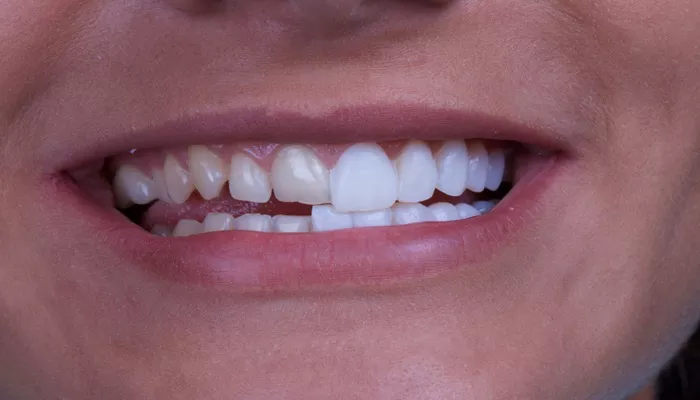Dental veneers are thin shells, usually made of porcelain or composite resin, that cover the front surface of teeth. They improve the appearance of teeth by changing their color, shape, size, or length. Veneers are popular for fixing issues like stained, chipped, or misaligned teeth.
Purpose of Dental Veneers
People choose veneers mainly for cosmetic reasons. Veneers provide a natural-looking smile and can boost confidence. However, they also protect damaged teeth and sometimes help improve function.
Factors Contributing to the High Cost of Dental Veneers
Material Quality
The materials used to make veneers significantly affect their price. Porcelain veneers are more expensive than composite resin veneers because porcelain mimics natural teeth better. Porcelain is also stronger and resists stains well. High-quality materials cost more to produce and shape.
Customization and Craftsmanship
Each veneer is custom-made to fit an individual’s tooth precisely. This requires detailed impressions, precise measurements, and skilled dental technicians who craft the veneer in a dental lab. The time and expertise involved add to the overall cost.
Advanced Dental Technology
Dentists use advanced tools like digital scanners and CAD/CAM technology to design and fabricate veneers. These technologies increase accuracy but also increase expenses for the dental office, which are reflected in the patient’s cost.
Multiple Appointments and Procedures
The process of getting veneers usually involves several visits to the dentist. These visits include consultation, tooth preparation, impressions, temporary veneers, and final placement. Each step requires time and effort, which adds to the cost.
Oral Health Factors Affecting Veneer Cost
Gum Disease and Bleeding Gums
Healthy gums are essential for successful veneers. If a patient has gum disease or bleeding gums, the dentist must treat these issues first. Treatment might include deep cleanings or periodontal therapy before veneers can be placed. This extra care increases the overall cost.
Tooth Preparation and Restoration
Sometimes teeth need to be reshaped or restored before veneers are placed. If a tooth has decay, cracks, or large fillings, the dentist might need to fix those problems first. These restorations increase treatment time and cost.
Laboratory Fees and Technician Expertise
Role of Dental Laboratories
Dental labs play a critical role in making veneers. They use specialized materials and equipment to produce high-quality, natural-looking veneers. Lab fees vary depending on the complexity and materials used. Premium labs charge more for superior craftsmanship.
Skilled Technicians
Experienced dental technicians who handcraft veneers add to the cost. Their skill ensures the veneers fit well and match the patient’s natural teeth color and texture. Custom artistry requires time and precision.
Geographical Location and Dentist’s Expertise
Location of Dental Practice
The cost of living and average income in a dentist’s area affects veneer prices. Clinics in large cities or affluent areas usually charge more. This is due to higher overhead costs such as rent, salaries, and utilities.
Experience of the Dentist
Highly skilled and reputable dentists charge higher fees for veneers. Their expertise ensures better results, reducing risks of complications. Patients often pay more for the quality and assurance experienced dentists provide.
Longevity and Maintenance of Veneers
Durability of Veneers
Dental veneers can last 10 to 15 years or longer if cared for properly. Their durability is linked to the materials used and the skill of the dentist. The upfront cost is high but veneers offer long-term value by maintaining the appearance and function of teeth.
Maintenance Costs
Although veneers resist stains and damage, patients must maintain good oral hygiene. Regular dental visits are necessary to check for gum inflammation or any problems. If veneers chip or crack, repairs can be expensive.
Insurance Coverage and Financial Considerations
Dental Insurance and Veneers
Most dental insurance plans consider veneers a cosmetic procedure and do not cover them. However, if veneers are necessary for dental health reasons, such as to protect teeth damaged by gum disease or injury, some insurance plans may cover part of the cost.
Payment Plans and Alternatives
Many dental offices offer payment plans to make veneers more affordable. Alternatives like composite veneers or teeth whitening may cost less but might not last as long or provide the same results.
Common Misconceptions About Veneer Costs
Cheap Veneers vs. Quality Veneers
Low-cost veneers might seem attractive but often lack durability and aesthetics. Cheap materials or inexperienced dentists can lead to poor results, which can cause additional dental issues like gum irritation or increased bleeding gums.
Veneers Are Only Cosmetic
While veneers improve appearance, they also protect weakened teeth. For patients with teeth affected by decay or gum disease, veneers serve a restorative purpose that justifies the investment.
Conclusion
Dental veneers are expensive due to many factors. These include the quality of materials, the skill required to craft and place them, the need for healthy gums free from gum disease or bleeding gums, and the technology involved. Location and dentist expertise also influence cost. Despite the high price, veneers offer long-lasting benefits for both the appearance and health of teeth. Patients should weigh the costs against the value of a durable, natural-looking smile and consult their dentist about the best options for their oral health needs.

